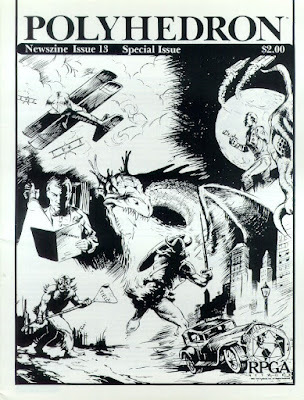Polyhedron: Issue #13
Issue #13 of Polyhedron (August 13) is dubbed a "special issue," because, in the words of its editor, Mary Kirchoff, more "strictly gaming aid articles." What that means is that, unlike previous issues, this one includes no RPGA ephemera, only articles for use with TSR's various roleplaying games. This is precisely what I'd hoped to see in the pages of Polyhedron when I first started to subscribe to it. Alas, the 'zine would return to its earlier form with issue #14, but I nevertheless enjoyed this one, singular though it was.
The letters page contains two letters of note. One asks about the possibility of a D&D movie, while the other questions why Deities & Demigods includes "fighting abilities and statistics" for the gods described therein. Here's the response regarding a D&D movie:
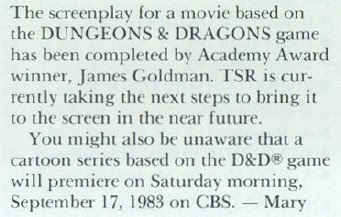 The story of the D&D movie Gary Gygax was supposedly working on during his time in Hollywood is the stuff of legend. I know very little about it myself, but Jon Peterson, has written a lengthy essay about its history and development that's well worth your time.
The story of the D&D movie Gary Gygax was supposedly working on during his time in Hollywood is the stuff of legend. I know very little about it myself, but Jon Peterson, has written a lengthy essay about its history and development that's well worth your time. The Deities & Demigods question is interesting, both for the answer (provided by DDG co-author James M. Ward) and for its asker, a name that might be recognizable to those familiar with the luminaries of the OSR:
 And here is Ward's answer:
And here is Ward's answer: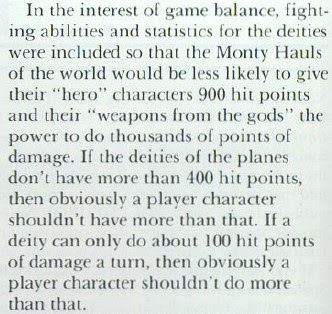 This is pretty much the same logic employed by Tim Kask in the foreword to Gods, Demigods & Heroes, the predecessor to the DDG. I'm not entirely sure what to make of it, except that it suggests TSR felt a need to police the boundaries of power within D&D. What an odd thing!
This is pretty much the same logic employed by Tim Kask in the foreword to Gods, Demigods & Heroes, the predecessor to the DDG. I'm not entirely sure what to make of it, except that it suggests TSR felt a need to police the boundaries of power within D&D. What an odd thing!"Dispel Confusion" contains the usual assortment of questions about TSR's stable of roleplaying games. Of these, one stands out as worthy of being highlighted:
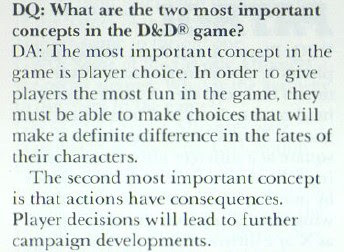 One can quibble about whether these are indeed "the two most important concepts in the D&D game," but I find it difficult to disagree that both of these concepts in the answer are indeed significant ones, particularly the second one. My ongoing House of Worms campaign – which will celebrate its ninth year of continuous play in March 2024 – is largely propelled by player choice and the consequences of those choices, for example.
One can quibble about whether these are indeed "the two most important concepts in the D&D game," but I find it difficult to disagree that both of these concepts in the answer are indeed significant ones, particularly the second one. My ongoing House of Worms campaign – which will celebrate its ninth year of continuous play in March 2024 – is largely propelled by player choice and the consequences of those choices, for example.Mary Kirchoff provides another installment of "Under Construction," this one being something of a follow-up to the one that appeared in issue #10. Like its predecessor, it's clever and flavorful – a good example of a dungeon "special." The issue also includes a "policy statement" from the publishing division of TSR, regarding Dragon and the newly-acquired Ares :
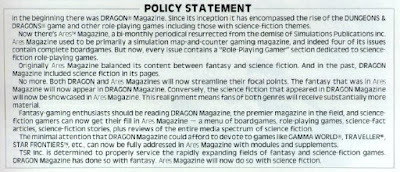 In short, TSR decided to focus Dragon solely on fantasy RPGs, shifting science fiction RPGs over to Ares. This was a huge disappointment to me at the time, because then, as now, I prefer SF to fantasy and I had no interest in subscribing to yet another gaming magazine. Ultimately, like everything else TSR did with the former SPI's properties, this move was ill-considered and failed. In time, Ares would cease to exist as a stand-alone magazine and sci-fi content would be re-incorporated into Dragon in the form of the Ares Section, which would become one of my favorite parts of the magazine.
In short, TSR decided to focus Dragon solely on fantasy RPGs, shifting science fiction RPGs over to Ares. This was a huge disappointment to me at the time, because then, as now, I prefer SF to fantasy and I had no interest in subscribing to yet another gaming magazine. Ultimately, like everything else TSR did with the former SPI's properties, this move was ill-considered and failed. In time, Ares would cease to exist as a stand-alone magazine and sci-fi content would be re-incorporated into Dragon in the form of the Ares Section, which would become one of my favorite parts of the magazine.Roger E. Moore's "Gods, Demigods, and DMs" is yet another look at the apparently vexed question of how to handle interactions between deities and powerful player characters. Moore's advice is generally very good, relying on both mythological tales, the AD&D rules, and common sense as guides. He quite reasonably believes that the gods should not be seen as "pushovers" even by the mightiest PCs and that the DM should pull out all the stops when roleplaying gods and demigods that their awesomeness is fully manifest. As I said, he provides lots of solid advice and examples, but I still have to wonder: were battles with the gods so commonplace that TSR needed to address it again and again?
"Spelling Bee" by James M. Ward looks at just two spells: continual light and its reverse, continual darkness, in order to show how versatile and useful they can be in play. I appreciate articles like this, because I've long felt that (A)D&D has too many spells, especially when one considers how many ways even a handful of spells can be used by a clever caster. Pointing out all the ways existing spells might be employed goes some way, I think, toward alleviating the need for further, ever more specific, spells – at least that's my feeling.
"The Hive Master" by Harold Johnson is an unusual four-page adventure for use with Gangbusters. I say "unusual," because, unlike all previous scenarios written for the game, this one doesn't deal with bootlegging or bank robbery but instead with efforts by a mad scientist – Professor Abe Malefica – to get his revenge on the world who mocked him by releasing a specially-bred type of harvester bee into the world. It's pulp nonsense of the highest order and I hated it at the time. Looking at it now, though, I have a better appreciation for what Johnson was doing, even if he refers to Malefica as an "entymologist."
The issue includes a double-sided cardstock reference sheet of Dawn Patrol rules and tables. I still have mine inside my game box to this day. "Ecosystem," another by Ward, looks at the ramifications of the environment in Gamma World on adventure scenarios. "Go West, Young Gamer" by Steve Winter suggests the inclusion of four new ability scores to Boot Hill – Coordination, Observation, Stature, and Luck – as a way to further differentiate characters in the game. Given that BH is a very primitive game in terms of mechanics, this makes some sense. Does anyone know if these were these incorporated into the third edition of the game by chance?
"Raid on Theseus" by Doug Niles is a starship combat scenario for use with Knight Hawks. Kim Mohan's "Psionic Pspells" is a lengthy (four pages) article looking at "spells resembling psionic powers" from every possible angle. These spells are enumerated in Appendix C of the AD&D Dungeon Masters Guide, but Mohan is, for some reason, interested in explaining the logic behind each spell's inclusion in the list in order to better understand AD&D magic, psionics, and the interplay of the two. I cannot say I share his enthusiasm for the topic. "The Condor Assignment" by Allen Hammack is ostensibly a Top Secret article, but it's mostly a review of then-current espionage media, like the Bond novel, Icebreaker.
Other than the obligatory RPGA catalog at the end, that's issue #13. Though no longer than its immediate predecessors, it certainly feels meatier to me, probably because of the lack of RPGA ephemera that didn't interest me at the time and interests me even less four decades later. This issue represents what I always wanted Polyhedron to be, but very rarely got – a pity.
James Maliszewski's Blog
- James Maliszewski's profile
- 3 followers


